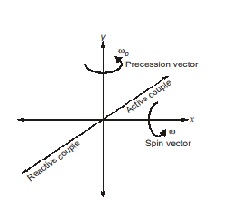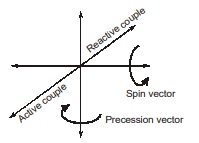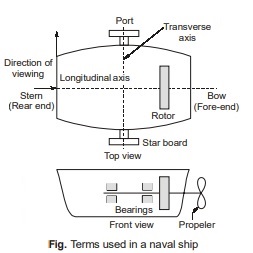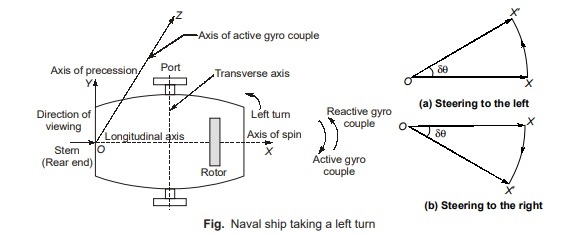Gyroscopic Effect on Aeroplanes
Let us analyse the effect of gyroscopic couple acting on the body of aeroplane for various conditions.
Let the propeller be rotating in the clockwise direction when viewed from the rear end:

• Taking left turn

The left turning of aeroplane would result in precession in the counter clockwise direction as seen from the top. So, the reactive gyroscopic couple tends to dip the tail and raise the nose of aeroplane.
• Taking right turn:

The right turning of aeroplane would result in precession in the clockwise direction as seen from the top. So the reactive gyroscopic couple tends to dip the nose and raise the tail of aeroplane.
• Similarly following cases can be understood:
1. When propeller rotates in clockwise direction when viewed from front end and left and right turn occur.
2. When propeller rotates in counter clockwise direction from the rear end and left and right turn occur.
3. When propeller rotates in counter clockwise direction from front end and left and right turn occur.
Gyroscopic Effect on Naval Ships 
Terms used in a Naval Ship
- Bow is the fore end or the front end
- Stern is the rear end
- Starboard is the right-hand side when looking from the Stern.
- Port is the left-hand side when looking from the stern.
- Steering is turning on the side when viewing from the top
- Pitching is limited angular motion of the ship about the transverse axis
- Rolling is limited angular motion of the ship about the longitudinal axis
Effect of Gyroscopic Couple on a Naval Ship during Steering
Steering is the turning of a complete ship in a curve towards left or right, while it moves forward. Consider the
ship taking a left turn, and rotor rotates in the clockwise direction when viewed from the stern, as shown in figure
below. The effect of gyroscopic couple on a naval ship during steering taking left or right turn may be obtained in a
similar way as for an aeroplane as discussed in Article 11.4

When the rotor of the ship rotates in the clockwise direction when viewed from the stern, it will have its angular momentum vector in the direction ox as shown in figure (a) above. As the ship steers to the left, the active gyroscopic couple will change the angular momentum vector from ox to ox′. The vector xx′ now represents the active gyroscopic couple and is perpendicular to ox. Thus the plane of active gyroscopic couple is perpendicular to xx’ and its direction in the axis OZ for the left hand turn is clockwise. The reactive gyroscopic couple of the same magnitude will act in the opposite direction (i.e. in anticlockwise direction). The effect of this reactive gyroscopic couple is to raise the bow and lower the stern.

